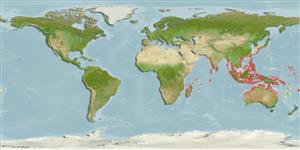Environment: milieu / climate zone / depth range / distribution range
Ecology
Marine; brackish; demersal. Tropical
Indo-West Pacific: Sri Lanka, east coast of India, Andaman and Nicobar islands to western Malaysia (Penang) and Indonesia, east to the Philippines and the Ryukyu Islands, Japan.
Size / Weight / Age
Maturity: Lm ? range ? - ? cm
Max length : 11.0 cm TL male/unsexed; (Ref. 48636)
Dorsal
spines
(total): 4;
Dorsal
soft rays
(total): 9;
Anal
soft rays: 9. Head and body brown or yellow, belly lighter. Back with small light spots and dark blotches. First dorsal fin black. Anal fin whitish. Pelvic fins dark and brown or black. Second dorsal, caudal, and pectoral fins spotted with dark brown. Body without lateral fold of skin below lateral line. Interorbital distance more than eye diameter (Ref 42832).
Inhabits shallow sandy and muddy bottoms in the sea, but also enters mouths of rivers and may live even in freshwater .
Life cycle and mating behavior
Maturity | Reproduction | Spawning | Eggs | Fecundity | Larvae
Talwar, P.K. and A.G. Jhingran, 1991. Inland fishes of India and adjacent countries. Volume 2. A.A. Balkema, Rotterdam, i-xxii + 543-1158, 1 pl. (Ref. 4833)
IUCN Red List Status (Ref. 130435)
Threat to humans
Harmless
Human uses
Fisheries: of no interest
More information
Common namesSynonymsMetabolismPredatorsEcotoxicologyReproductionMaturitySpawningSpawning aggregationFecundityEggsEgg development
ReferencesAquacultureAquaculture profileStrainsGeneticsElectrophoresesHeritabilityDiseasesProcessingNutrientsMass conversion
Tools
Special reports
Download XML
Internet sources
Estimates based on models
Preferred temperature (Ref.
123201): 25.1 - 29.3, mean 28.6 °C (based on 2815 cells).
Phylogenetic diversity index (Ref.
82804): PD
50 = 1.0000 [Uniqueness, from 0.5 = low to 2.0 = high].
Bayesian length-weight: a=0.00794 (0.00359 - 0.01758), b=2.80 (2.61 - 2.99), in cm total length, based on LWR estimates for this (Sub)family-body shape (Ref.
93245).
Trophic level (Ref.
69278): 3.3 ±0.4 se; based on size and trophs of closest relatives
Resilience (Ref.
120179): High, minimum population doubling time less than 15 months (Preliminary K or Fecundity.).
Fishing Vulnerability (Ref.
59153): Low vulnerability (10 of 100).
